Three-Dimensional Coupled Temporal Geomechanical Model for Fault-Reactivation and Surface-Deformation Evaluation during Reservoir Depletion and CO2 Sequestration, Securing Long-Term Reservoir Sustainability
Abstract
:1. Introduction
- Coupled Fluid Flow and Geomechanics Models: These models consider the simultaneous interaction between fluid flow (e.g., multiphase flow, fluid injection) and the mechanical response of the reservoir rock. They account for changes in pore pressure, stress distribution, and deformation during fluid flow processes [21,22].
- Thermal–Hydrological–Mechanical (THM) Coupled Models: THM models integrate thermal, hydraulic, and mechanical processes to analyze the effects of temperature changes, fluid flow, and mechanical loading on reservoir behavior [23,24]. They are particularly relevant in geothermal reservoirs or applications involving thermal recovery techniques [25,26].
- Reservoir Compaction Models: These models focus on predicting reservoir compaction due to fluid production or injection. They consider the mechanical properties of the rock, pore-pressure changes, and stress redistribution to simulate compaction-induced subsidence and its impact on reservoir performance [4,23,26].
- This categorization depends on the complexity involved in developing a simulator and the level of consistency in results needed to solve for the primary variables [20,27]. One-way coupling simplifies the computational complexity compared to fully coupled models, making simulations more computationally efficient. This allows for faster model execution and analysis, particularly for large-scale reservoir simulations [28].
- One-way coupled fluid flow and geomechanics models offer a balance between computational efficiency and insight into reservoir behavior, making them valuable tools for reservoir engineering studies and decision-making processes [29,30]. By adding time as the fourth dimension, these models facilitate a more accurate portrayal of reservoir dynamics, accommodating fluctuations in pressure, stress, and rock deformation throughout the production lifecycle. This temporal inclusion proves invaluable for forecasting the enduring impacts of fluid extraction on subsurface stability [26,30].
2. Geological Setting
3. Available Data and Methodology
- Formation markers.
- Drilling and completion report.
- Graphic well logs.
- Final geological reports.
- Compressional and shear velocity.
- Conventional full-suit logs.
- Static formation pressure data.
- Caliper logs.
- Geomechanical and petrophysical core data.
- Seismic inversion results (Table 1).
4. Results and Discussion
4.1. 1D Geomechanical Modeling
4.2. Mechanical Earth Model (MEM)
4.2.1. Geometry of the Model and 3D Finite-Element Mesh
4.2.2. Elastic Properties
4.2.3. Pore Pressure
4.3. Discontinuity Modeling
4.4. Boundary Condition
4.4.1. Horizontal-Stress Direction
4.4.2. Vertical- and Horizontal-Stress Magnitudes
4.5. Coupling of Geomechanical and Dynamic Models
4.6. Simulation Validation
4.7. Stress and Strain Analyses, Shear Failure, Fault Reactivation and Subsidence
4.8. Comparing with Related Studies
4.9. Analysis and Evaluation of CO2 Storage in a Depleted Reservoir
5. Conclusions
- The results from the 1D modeling are then utilized to populate a 3D geomechanical model (3D MEM) with elastic properties. This process involves employing the kriging interpolation method, which is weighted by seismic inversion results.
- Subsequently, the geomechanical model is integrated with a dynamic hydraulic model to ascertain the pore-pressure field within the reservoir for specific time increments. This integration enables the simulation of total and effective stresses, as well as related deformation within and outside the reservoir, including surface displacement.
- The workflow was effectively applied to a gas reservoir case study situated in the southwest of Iran. Modeling outcomes were meticulously calibrated against diverse observational datasets. The validated 3D geomechanical model furnishes comprehensive stress-state information at any location within the model domain. These data can be beneficial, for instance, in devising future well trajectories.
- The total stresses increase while depilation and effective stresses decrease while depilating in all directions, especially in the Z direction.
- The predicted compaction in the reservoir and overburden was 0.35 m.
- Most of the compaction was observed above the reservoir, and its magnitude decreased approaching the seabed.
- The case evaluated displayed no failure, including formation damage or fault reactivation in the Kangan–Dalam Formation layers located in the simulated area.
- Additionally, the modeling results offer insights into surface ground movement during periods of depletion and replenishment. The workflow delineated and assessed in this study is not constrained to a specific site but is broadly applicable to gas storage in porous media, encompassing methane, CO2, and hydrogen.
- The results of this study demonstrate that CO2 injection into a depleted reservoir can effectively mitigate the geohazards associated with depletion, such as surface subsidence and stress alterations. By maintaining or increasing pore pressure through CO2 storage, the compaction and subsidence typically observed during reservoir depletion are significantly reduced. The redistribution of stresses within the reservoir helps to maintain its mechanical stability, lowering the risk of fault reactivation and structural failure.
- The 25-year geomechanical analysis shows that the reservoir remains stable under CO2 injection, with no evidence of shear failure or significant fault reactivation. This indicates that CO2 storage can enhance the reservoir’s structural integrity while mitigating the adverse effects of depletion. Continuously monitoring stresses and strain will be essential to ensure safe and effective storage, especially in managing subsidence risks near populated areas or infrastructure.
Author Contributions
Funding
Institutional Review Board Statement
Informed Consent Statement
Data Availability Statement
Conflicts of Interest
References
- French, S.; Puspitasari, R.; Isherwood, A.; Cox, P.; Energy, O.; Marsden, R.; Rock, M.; Ndong, M.; Mbang, E.; Chee, P.; et al. SPE/IADC-184603-MS 4-D Geomechanics to Predict Compaction and Subsidence for Development of Unconsolidated Sandstone Reservoirs: Fortuna Project Case Study, Offshore Equatorial Guinea. In Proceedings of the SPE/IADC Drilling Conference and Exhibition, Hague, The Netherlands, 14 March 2017. [Google Scholar] [CrossRef]
- Hosseinzadeh, S.; Kadkhodaie, A.; Yarmohammadi, S. NMR derived capillary pressure and relative permeability curves as an aid in rock typing of carbonate reservoirs. J. Pet. Sci. Eng. 2020, 184, 106593. [Google Scholar] [CrossRef]
- Hosseinzadeh, S.; Kadkhodaie, A.; Wood, D.A.; Rezaee, R.; Kadkhodaie, R. Discrete fracture modeling by integrating image logs, seismic attributes, and production data: A case study from Ilam and Sarvak Formations, Danan Oilfield, southwest of Iran. J. Pet. Explor. Prod. Technol. 2023, 13, 1053–1083. [Google Scholar] [CrossRef]
- Dung, T.Q. Coupled Fluid Flow-Geomechanics Simulations Applied to Compaction and Subsidence Estimation in Stress Sensitive & Heterogeneous Reservoirs. Ph.D. Thesis, Australian School of Petroleum, Adelaide, Australia, 2007. [Google Scholar]
- Zoccarato, C.; Ferronato, M.; Teatini, P. Formation compaction vs. land subsidence to constrain rock compressibility of hydrocarbon reservoirs. Geomech. Energy Environ. 2018, 13, 14–24. [Google Scholar] [CrossRef]
- Lizárraga, J.J.; Buscarnera, G. A geospatial model for the analysis of time-dependent land subsidence induced by reservoir depletion. Int. J. Rock Mech. Min. Sci. 2020, 129, 104272. [Google Scholar] [CrossRef]
- Abdollahi, R.; Hosseinzadeh, S.; Movassagh, A.; Kasperczyk, D.; Haghighi, M. Imaging Pressure Distribution in Geological Reservoirs from Surface Deformation Data. Sustainability 2024, 16, 7710. [Google Scholar] [CrossRef]
- Sun, H.; Liu, X.; Ye, Z.; Wang, E. Experimental investigation of the nonlinear evolution from pipe flow to fissure flow during carbonate rock failures. Bull. Eng. Geol. Environ. 2021, 80, 4459–4470. [Google Scholar] [CrossRef]
- Liu, Z.; Liu, R. A fully implicit and consistent finite element framework for modeling reservoir compaction with large deformation and nonlinear flow model. Part I: Theory and formulation. Comput. Geosci. 2018, 22, 623–637. [Google Scholar] [CrossRef]
- Belousov, A.; Lushpeev, V.; Sokolov, A.; Sultanbekov, R.; Tyan, Y.; Ovchinnikov, E.; Shvets, A.; Bushuev, V.; Islamov, S. Hartmann–Sprenger Energy Separation Effect for the Quasi-Isothermal Pressure Reduction of Natural Gas: Feasibility Analysis and Numerical Simulation. Energies 2024, 17, 2010. [Google Scholar] [CrossRef]
- Islamov, S.; Islamov, R.; Shelukhov, G.; Sharifov, A.; Sultanbekov, R.; Ismakov, R.; Agliullin, A.; Ganiev, R. Fluid-Loss Control Technology: From Laboratory to Well Field. Processes 2024, 12, 114. [Google Scholar] [CrossRef]
- David, C.; Le Ravalec-Dupin, M. Rock Physics and Geomechanics in the Study of Reservoirs and Repositories; The Geological Society of London: London, UK, 2007; Volume 284, pp. 1–14. [Google Scholar] [CrossRef]
- Liu, L.; Huang, Z.; Yao, J.; Lei, Q.; Di, Y.; Wu, Y.-S.; Zhang, K.; Cui, S. Simulating two-phase flow and geomechanical deformation in fractured karst reservoirs based on a coupled hydro-mechanical model. Int. J. Rock Mech. Min. Sci. 2021, 137, 104543. [Google Scholar] [CrossRef]
- Sangnimnuan, A.; Li, J.; Wu, K. Development of coupled two phase flow and geomechanics model to predict stress evolution in unconventional reservoirs with complex fracture geometry. J. Pet. Sci. Eng. 2021, 196, 108072. [Google Scholar] [CrossRef]
- Xiao, F.; Salimzadeh, S.; Zhang, Q.-B. Opening versus shearing of a fluid-driven fault reactivation. Aust. Energy Prod. J. 2024, 64, S298–S301. [Google Scholar] [CrossRef]
- Yuan, B.; Wood, D.A. A holistic review of geosystem damage during unconventional oil, gas and geothermal energy recovery. Fuel 2018, 227, 99–110. [Google Scholar] [CrossRef]
- Dusseault, M.B. Coupled Processes and Petroleum Geomechanics. In Elsevier Geo-Engineering Book Series; Elsevier: Amsterdam, The Netherlands, 2004; pp. 49–62. [Google Scholar] [CrossRef]
- Dusseault, M.B. Geomechanical challenges in petroleum reservoir exploitation. KSCE J. Civ. Eng. 2011, 15, 669–678. [Google Scholar] [CrossRef]
- Liu, K.; Hosseinzadeh, S.; Safaei-Farouji, M.; Liu, B.; Morta, H.B.; Ostadhassan, M. Fracture toughness of organic rich shale via nanoindentation: A comparison of energy-based methods. Geoenergy Sci. Eng. 2023, 225, 211695. [Google Scholar] [CrossRef]
- Teatini, P.; Castelletto, N.; Gambolati, G. 3D geomechanical modeling for CO2 geological storage in faulted formations. A case study in an offshore northern Adriatic reservoir, Italy. Int. J. Greenh. Gas Control 2014, 22, 63–76. [Google Scholar] [CrossRef]
- Hosseinzadeh, S.; Haghighi, M.; Salmachi, A.; Shokrollahi, A. Carbon dioxide storage within coal reservoirs: A comprehensive review. Geoenergy Sci. Eng. 2024, 241, 213198. [Google Scholar] [CrossRef]
- Ye, Z.; Liu, X.; Sun, H.; Dong, Q.; Du, W.; Long, Q. Variations in Permeability and Mechanical Properties of Basaltic Rocks Induced by Carbon Mineralization. Sustainability 2022, 14, 15195. [Google Scholar] [CrossRef]
- Maerten, L.; Legrand, X.; Castagnac, C.; Lefranc, M.; Joonnekindt, J.P.; Maerten, F. Fault-related fracture modeling in the complex tectonic environment of the Malay Basin, offshore Malaysia: An integrated 4D geomechanical approach. Mar. Pet. Geol. 2019, 105, 222–237. [Google Scholar] [CrossRef]
- Ye, Z.; Liu, X.; Dong, Q.; Wang, E.; Sun, H. Hydro-Damage Properties of Red-Bed Mudstone Failures Induced by Nonlinear Seepage and Diffusion Effect. Water 2022, 14, 351. [Google Scholar] [CrossRef]
- Lewis, R.W.; Makurat, A.; Pao, W.K.S. Fully coupled modeling of seabed subsidence and reservoir compaction of North Sea oil fields. Hydrogeol. J. 2003, 11, 142–161. [Google Scholar] [CrossRef]
- Moid, F.; Hamid, O. 4D Geomechanics Application for Successful Well Drilling Plan. In Proceedings of the ADIPEC, Abu Dhabi, United Arab Emirates, 3 October 2023. Society of Petroleum Engineers. [Google Scholar] [CrossRef]
- De Santis, F.; Renaud, V.; Gunzburger, Y.; Kinscher, J.; Bernard, P.; Contrucci, I. In situ monitoring and 3D geomechanical numerical modelling to evaluate seismic and aseismic rock deformation in response to deep mining. Int. J. Rock Mech. Min. Sci. 2020, 129, 104273. [Google Scholar] [CrossRef]
- Guerra, C.; Fischer, K.; Henk, A. Stress prediction using 1D and 3D geomechanical models of a tight gas reservoir—A case study from the Lower Magdalena Valley Basin, Colombia. Geomech. Energy Environ. 2019, 19, 100113. [Google Scholar] [CrossRef]
- Ambati, V.; Mahadasu, N.B.; Koehn, D.; Nair, R.R. Construction of a 3D geomechanical model using integrated workflow to study zones causing subsidence and wellbore instabilities. Geomech. Geophys. Geo-Energy Geo-Resources 2021, 7, 83. [Google Scholar] [CrossRef]
- Shad, S.; Kolahkaj, P.; Zivar, D. Geomechanical analysis of an oil field: Numerical study of wellbore stability and reservoir subsidence. Pet. Res. 2023, 8, 350–359. [Google Scholar] [CrossRef]
- Ranjbar, A.; Hassani, H.; Shahriar, K. 3D geomechanical modeling and estimating the compaction and subsidence of Fahlian reservoir formation (X-field in SW of Iran). Arab. J. Geosci. 2017, 10, 116. [Google Scholar] [CrossRef]
- Mahajan, S.; Hassan, H.; Duggan, T.; Dhir, R.; Development, P. SPE-192744-MS Compaction and Subsidence Assessment to Optimize Field Development Planning for an Oil Field in Sultanate of Oman. In Proceedings of the Abu Dhabi International Petroleum Exhibition & Conference, Abu Dhabi, United Arab Emirates, 14 November 2018. [Google Scholar] [CrossRef]
- Mehrabi, H.; Rahimpour-Bonab, H.; Hajikazemi, E.; Jamalian, A. Controls on depositional facies in Upper Cretaceous carbonate reservoirs in the Zagros area and the Persian Gulf, Iran. Facies 2015, 61, 23. [Google Scholar] [CrossRef]
- Alsharhan, A.S.; Kendall, C.G.S.C. Paleozoic sequence stratigraphy, depositional systems, and hydrocarbon habitats across the Arabian plate. Am. Assoc. Pet. Geol. Bull. 2021, 105, 1149–1198. [Google Scholar] [CrossRef]
- Ezati, M.; Olfati, H.; Khadem, M.; Yazdanipour, M.R.; Mohammad, A. Petrophysical Evaluation of a Severely Heterogeneous Carbonate Reservoir; Electrical Image Logs Usage in Porosity Estimation. Open J. Geol. 2019, 9, 193–200. [Google Scholar] [CrossRef]
- Jafari, A.; Ao, S.; Jamei, S.; Ghasemi, H. Evolution of the Zagros sector of Neo-Tethys: Tectonic and magmatic events that shaped its rifting, seafloor spreading and subduction history. Earth-Sci. Rev. 2023, 241, 104419. [Google Scholar] [CrossRef]
- Kakemem, U.; Jafarian, A.; Husinec, A.; Adabi, M.H.; Mahmoudi, A. Facies, sequence framework, and reservoir quality along a Triassic carbonate ramp: Kangan Formation, South Pars Field, Persian Gulf Superbasin. J. Pet. Sci. Eng. 2021, 198, 108166. [Google Scholar] [CrossRef]
- Kaveh-Ahangar, S.; Nozaem, R.; Tavakoli, V. The effects of planar structures on reservoir quality of Triassic Kangan formation in the central Persian Gulf, an integrated approach. J. Afr. Earth Sci. 2023, 197, 104764. [Google Scholar] [CrossRef]
- Esrafili-Dizaji, B.; Rahimpour-Bonab, H. Effects of depositional and diagenetic characteristics on carbonate reservoir quality: A case study from the South Pars gas field in the Persian Gulf. Pet. Geosci. 2009, 15, 325–344. [Google Scholar] [CrossRef]
- Kadkhodaie, R.; Sohrabi, A.; Jodeyri-Agaii, R. A syngenetic classification of anhydrite textures in carbonate reservoirs and its relationship with reservoir quality: A case study from the Permo-Triassic Dalan and Kangan formations. Carbonates Evaporites 2022, 37, 44. [Google Scholar] [CrossRef]
- Sabouhi, M.; Kadkhodaie, A.; Hosseinzadeh, S.; Batezelli, A. Seismic sequence stratigraphy of Late Albian-Early Turonian successions in SW Iran: Implication for reservoir characterizations and potential for improved reservoir quality prediction. J. Afr. Earth Sci. 2024, 214, 105269. [Google Scholar] [CrossRef]
- Sharland, P.R.; Casey, D.M.; Davies, R.B.; Simmons, M.D.; Sutcliffe, O.E. Arabian Plate Sequence Stratigraphy—Revisions to SP2. GeoArabia 2004, 9, 199–214. [Google Scholar] [CrossRef]
- Rezavand, N.; Jahani, D.; Asilian, H. Facies, Sedimentary Environment and Sequence Stratigraphy of Dalan Formation in South Fars, Iran—(Qatar-South Fars Arch) Well ASL-A. Open J. Geol. 2016, 6, 944–962. [Google Scholar] [CrossRef]
- Gholami, R.; Rasouli, V.; Aadnoy, B.; Mohammadi, R. Application of in situ stress estimation methods in wellbore stability analysis under isotropic and anisotropic conditions. J. Geophys. Eng. 2015, 12, 657–673. [Google Scholar] [CrossRef]
- Zoback, M.D. Reservoir Geomechanics; Cambridge University Press: Cambridge, UK, 2007. [Google Scholar] [CrossRef]
- Li, Y.; Otsubo, M.; Kuwano, R. Interpretation of static and dynamic Young’s moduli and Poisson’s ratio of granular assemblies under shearing. Comput. Geotech. 2022, 142, 104560. [Google Scholar] [CrossRef]
- Sharifi, J.; Nooraiepour, M.; Amiri, M.; Mondol, N.H. Developing a relationship between static Young’s modulus and seismic parameters. J. Pet. Explor. Prod. Technol. 2023, 13, 203–218. [Google Scholar] [CrossRef]
- Cheng, B.; Xu, T.; Tang, J. Reservoir Brittleness Prediction Method Based on the Mohr–Coulomb Failure Criterion and Effective In Situ Stress Principle. Rock Mech. Rock Eng. 2022, 55, 5933–5951. [Google Scholar] [CrossRef]
- Khaksar, A.; Taylor, P.G.; Fang, Z.; Kayes, T.; Salazar, A.; Rahman, K. Rock Strength from Core and Logs, Where We Stand and Ways to Go. In All Days; SPE: Kuala Lumpur, Malaysia, 2009. [Google Scholar] [CrossRef]
- Yang, L.; Ge, H.; Shen, Y.; Zhang, J.; Yan, W.; Wu, S.; Tang, X. Imbibition inducing tensile fractures and its influence on in-situ stress analyses: A case study of shale gas drilling. J. Nat. Gas Sci. Eng. 2015, 26, 927–939. [Google Scholar] [CrossRef]
- Liu, P.-H.; Wu, J.-H.; Lee, D.-H. New rock strength-based UCS-Vp correlation equation for different rock types by statistical regression methods. Geomech. Energy Environ. 2022, 32, 100403. [Google Scholar] [CrossRef]
- Najibi, A.R.; Ghafoori, M.; Lashkaripour, G.R.; Asef, M.R. Reservoir geomechanical modeling: In-situ stress, pore pressure, and mud design. J. Pet. Sci. Eng. 2017, 151, 31–39. [Google Scholar] [CrossRef]
- Motahari, M.; Hashemi, A.; Molaghab, A. Successful mechanical earth model construction and wellbore stability analysis using elastic and plasticity solutions, a case study. Geomech. Energy Environ. 2022, 32, 100357. [Google Scholar] [CrossRef]
- Eaton, B.A. The Effect of Overburden Stress on Geopressure Prediction from Well Logs. J. Pet. Technol. 1972, 24, 929–934. [Google Scholar] [CrossRef]
- Bowers, G.L. Determining an Appropriate Pore-Pressure Estimation Strategy. In Proceedings of the Offshore Technology Conference, Houston, TX, USA, 30 April–3 May 2001. All Days, OTC-13042-MS. [Google Scholar] [CrossRef]
- Ibrahim, A. A review of mathematical modelling approaches to tackling wellbore instability in shale formations. J. Nat. Gas Sci. Eng. 2021, 89, 103870. [Google Scholar] [CrossRef]
- Donald, J.A.; Neville, T.J. The Impact of Anisotropic Mechanical Properties on Stimulation and Wellbore Stability in the Beetaloo Basin, Northern Territory, Australia. In Proceedings of the 2021 Asia Pacific Unconventional Resources Technology Conference, Virtual, 16–18 November 2021. [Google Scholar] [CrossRef]
- Vernik, L.; Zoback, M.D. Estimation of maximum horizontal principal stress magnitude from stress-induced well bore breakouts in the Cajon Pass Scientific Research borehole. J. Geophys. Res. Solid Earth 1992, 97, 5109–5119. [Google Scholar] [CrossRef]
- Stephenson, R.; Schiffer, C.; Peace, A.; Nielsen, S.B.; Jess, S. Late Cretaceous-Cenozoic basin inversion and palaeostress fields in the North Atlantic-western Alpine-Tethys realm: Implications for intraplate tectonics. Earth-Sci. Rev. 2020, 210, 103252. [Google Scholar] [CrossRef]
- Lei, Q.; Gholizadeh Doonechaly, N.; Tsang, C.-F. Modelling fluid injection-induced fracture activation, damage growth, seismicity occurrence and connectivity change in naturally fractured rocks. Int. J. Rock Mech. Min. Sci. 2021, 138, 104598. [Google Scholar] [CrossRef]
- Han, H.; van der Baan, M. Constraint strategies for estimating in-situ stress from borehole measurements. Geomech. Energy Environ. 2024, 37, 100518. [Google Scholar] [CrossRef]
- Tang, Z.; Kong, X.; Duan, W.; Gao, J. Wellbore breakout analysis and the maximum horizontal stress determination using the thermo-poroelasticity model. J. Pet. Sci. Eng. 2021, 196, 107674. [Google Scholar] [CrossRef]
- Qi, S.; Tan, X.; Li, X.-P.; Meng, Z.; Xu, Y. Numerical simulation and experimental verification studies on a unified strength theory-based elastoplastic damage constitutive model of shale. Nat. Gas Ind. B 2021, 8, 267–277. [Google Scholar] [CrossRef]
- Giraldo-Londoño, O.; Paulino, G.H. A unified approach for topology optimization with local stress constraints considering various failure criteria: Von Mises, Drucker–Prager, Tresca, Mohr–Coulomb, Bresler– Pister and Willam–Warnke. Proc. R. Soc. A Math. Phys. Eng. Sci. 2020, 476, 20190861. [Google Scholar] [CrossRef]
- Gao, C.; Gray, K.E. A coupled geomechanics and reservoir simulator with a staggered grid finite difference method. J. Pet. Sci. Eng. 2022, 209, 109818. [Google Scholar] [CrossRef]
- Gudala, M.; Govindarajan, S.K. Numerical Modeling of Coupled Fluid Flow and Geomechanical Stresses in a Petroleum Reservoir. J. Energy Resour. Technol. 2020, 142, 063006. [Google Scholar] [CrossRef]
- Rabe, C.; Perdomo, P.R.R.; Roux, P.-F.; Silva, C.G.; Gamboa, L.A.P. Coupled fluid flow and geomechanics: A case study in Faja del Orinoco. Geomech. Geophys. Geo-Energy Geo-Resources 2020, 6, 14. [Google Scholar] [CrossRef]
- Cui, X.; Wong, L.N.Y. A 3D fully thermo–hydro–mechanical coupling model for saturated poroelastic medium. Comput. Methods Appl. Mech. Eng. 2022, 394, 114939. [Google Scholar] [CrossRef]
- Beck, M.; Rinaldi, A.P.; Flemisch, B.; Class, H. Accuracy of fully coupled and sequential approaches for modeling hydro- and geomechanical processes. Comput. Geosci. 2020, 24, 1707–1723. [Google Scholar] [CrossRef]
- Duran, O.; Sanei, M.; Devloo, P.R.B.; Santos, E.S.R. An enhanced sequential fully implicit scheme for reservoir geomechanics. Comput. Geosci. 2020, 24, 1557–1587. [Google Scholar] [CrossRef]
- Moorthy, P.R.S.; Chatterjee, A.; Younessi, A.; Ghosh, A. Reservoir Compaction and Surface Subsidence Assessment to Optimize Field Development Planning in Offshore Malay Basin, Malaysia. In Proceedings of the IADC/SPE Asia Pacific Drilling Technology Conference, APDT, Bangkok, Thailand, 9–10 August 2022; Society of Petroleum Engineers (SPE): Kuala Lumpur, Malaysia, 2022. [Google Scholar]
- Treffeisen, T.; Henk, A. Faults as Volumetric Weak Zones in Reservoir-Scale Hydro-Mechanical Finite Element Models—A Comparison Based on Grid Geometry, Mesh Resolution and Fault Dip. Energies 2020, 13, 2673. [Google Scholar] [CrossRef]
- Younessi, A.; Gui, F.; Guises, R.; Ngan, A.; Nadzri, S.; Zhou, C. OTC-28227-MS Evaluation of Reservoir Compaction and Geomechanical Related Risks Associated with Reservoir Production Using a Two-Way Coupled 4D Geomechanical Model for a Deep-Water Field in South East Asia. In Proceedings of the Offshore Technology Conference Asia, Kuala Lumpur, Malaysia, 20–23 March 2018. [Google Scholar] [CrossRef]
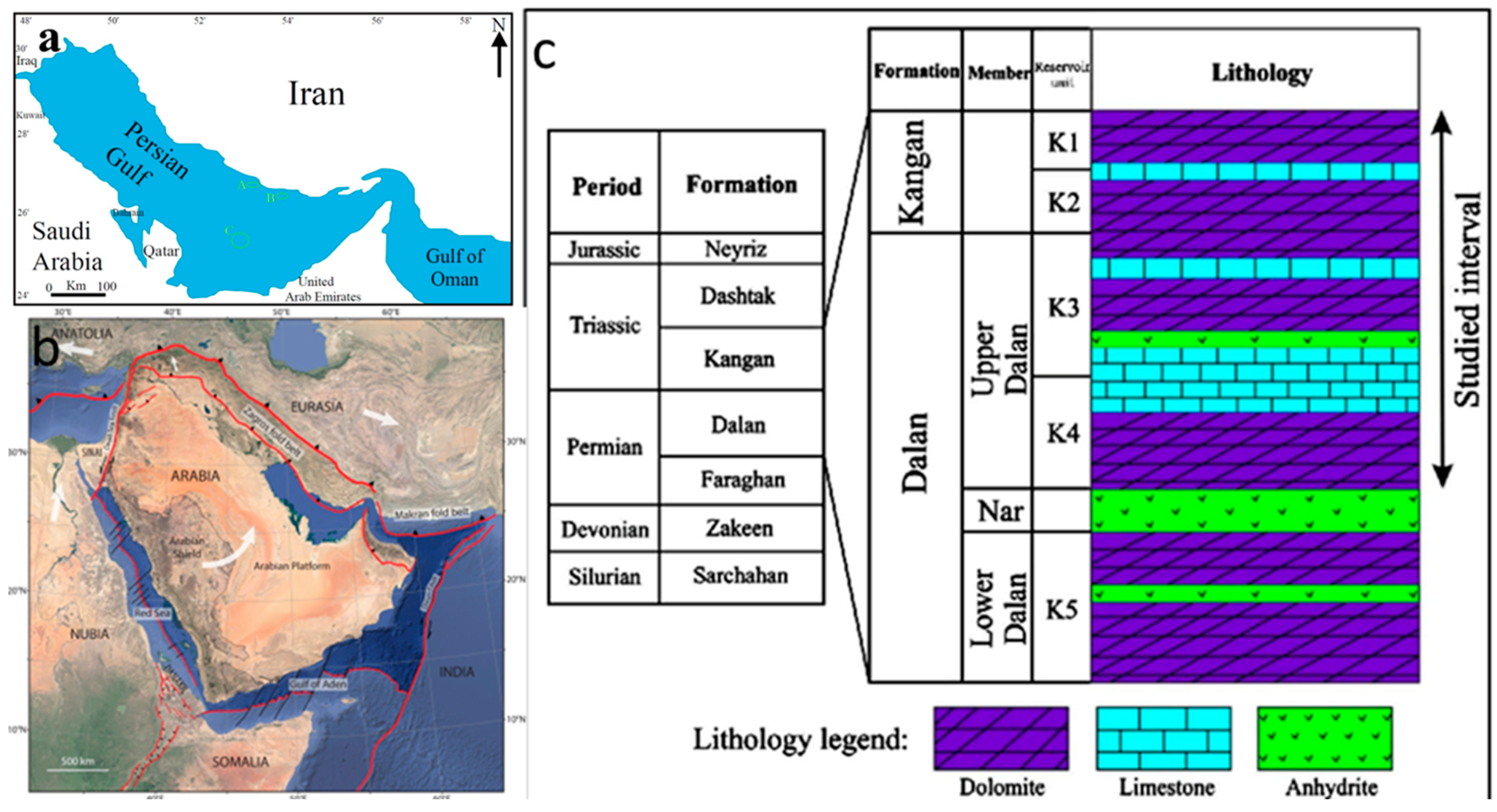
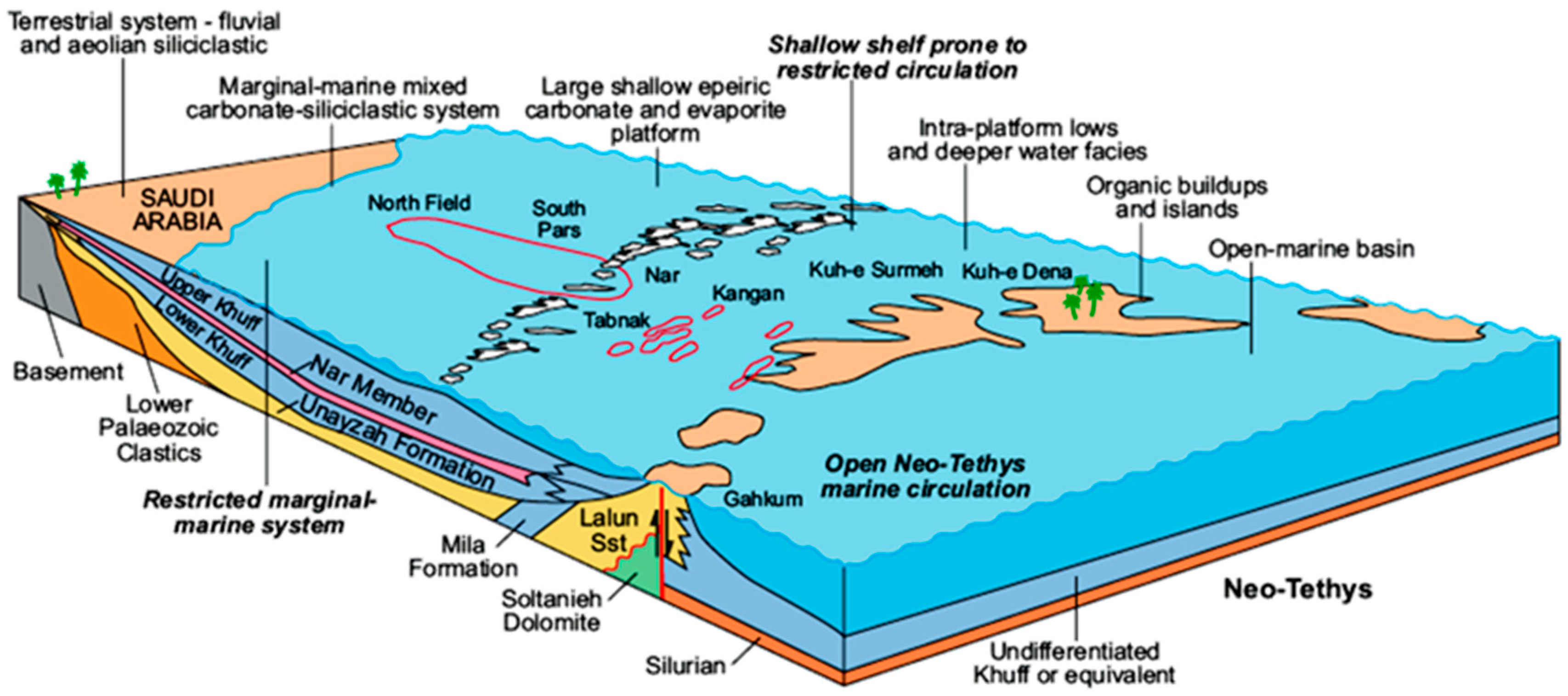
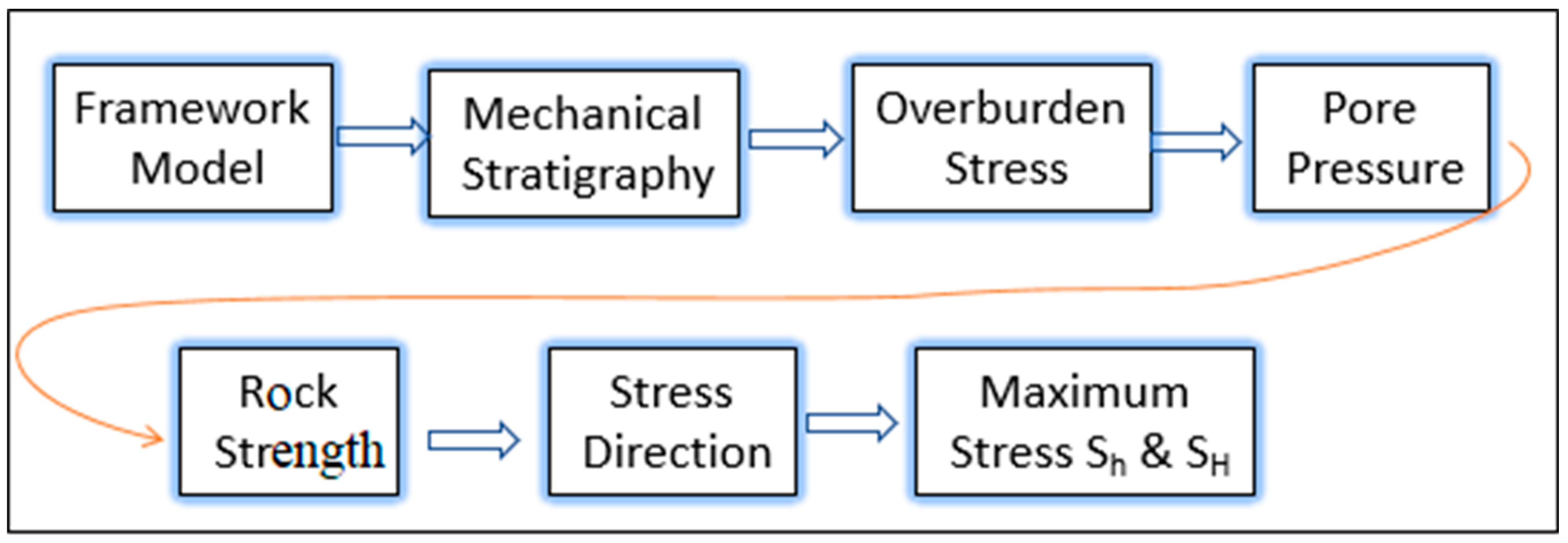
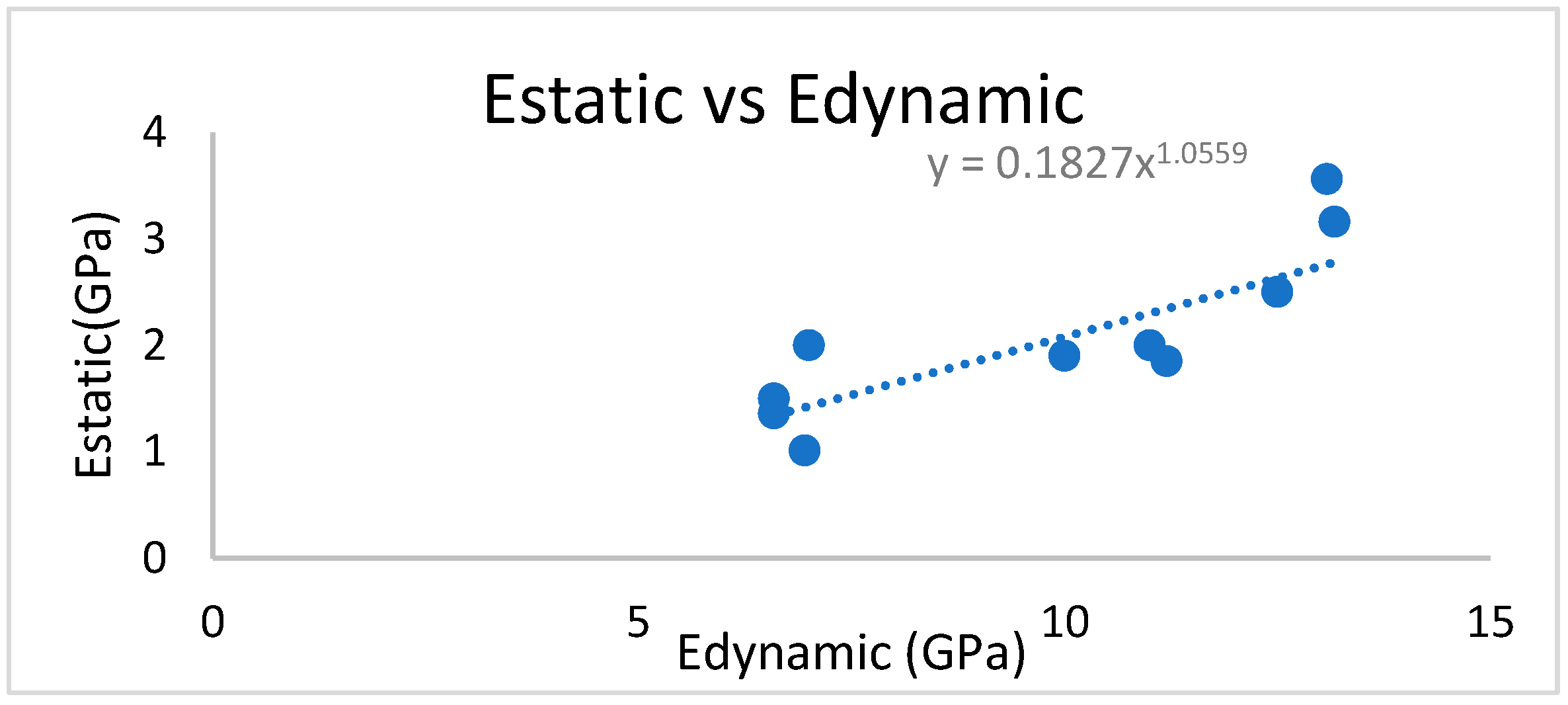
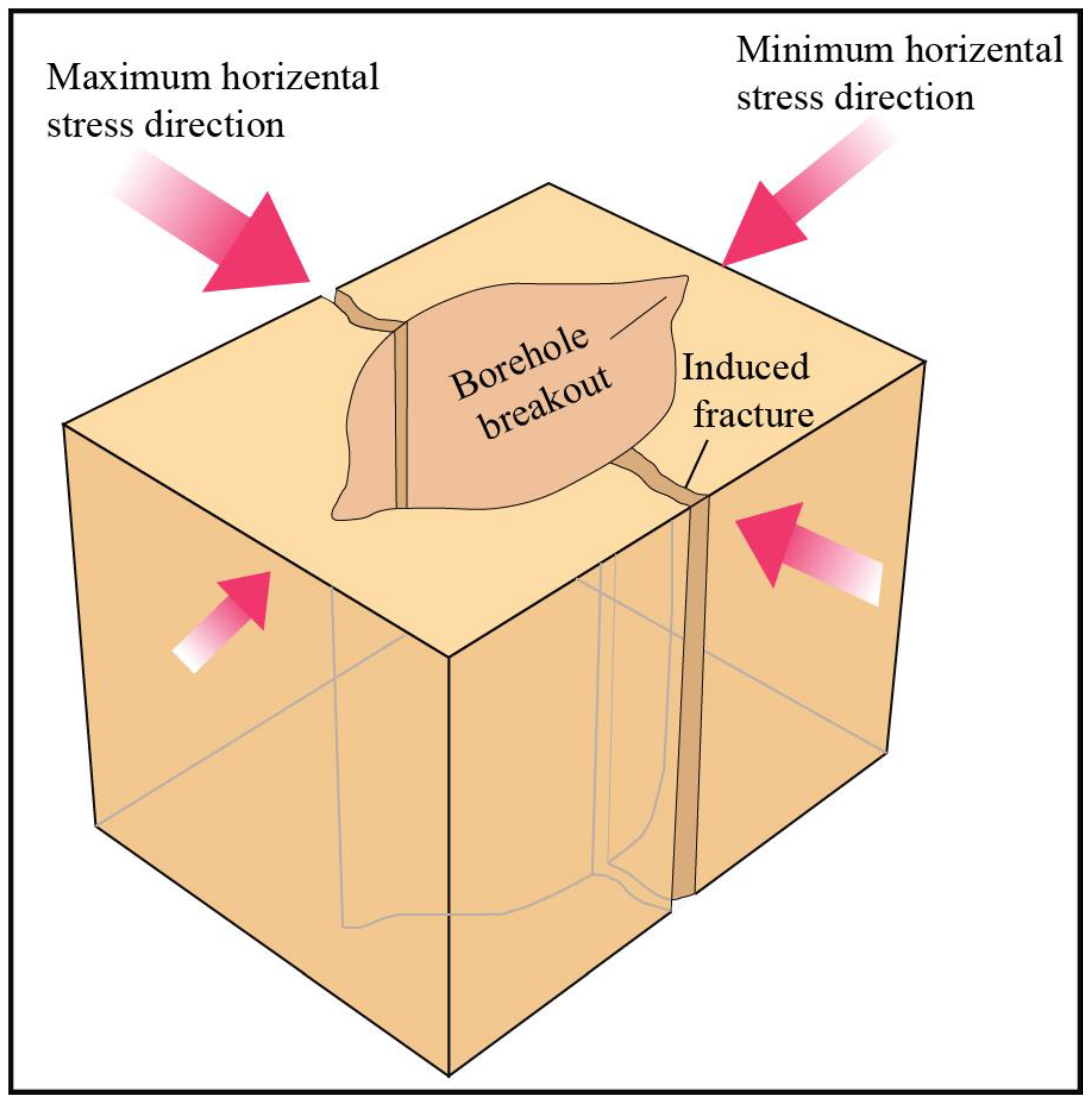
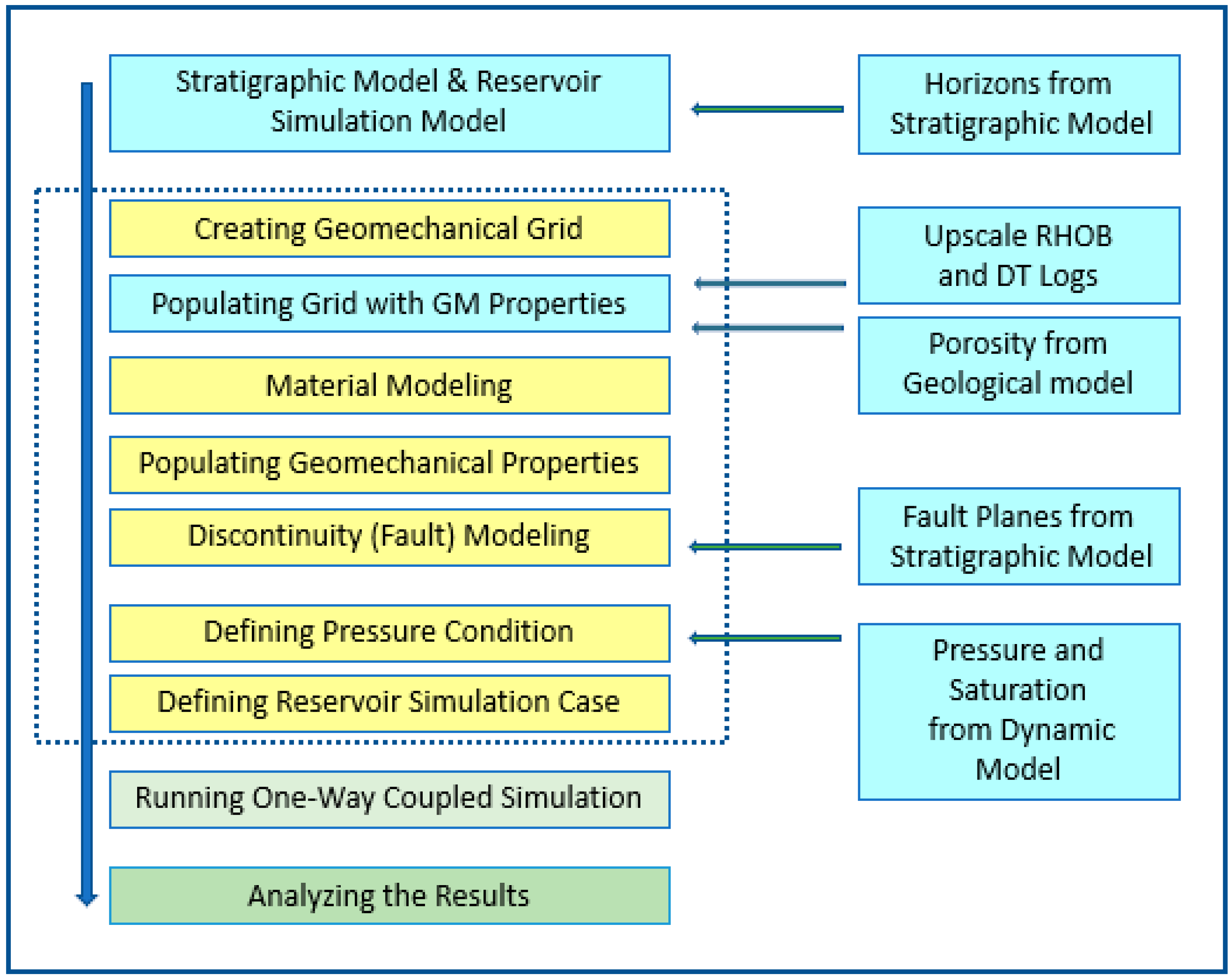
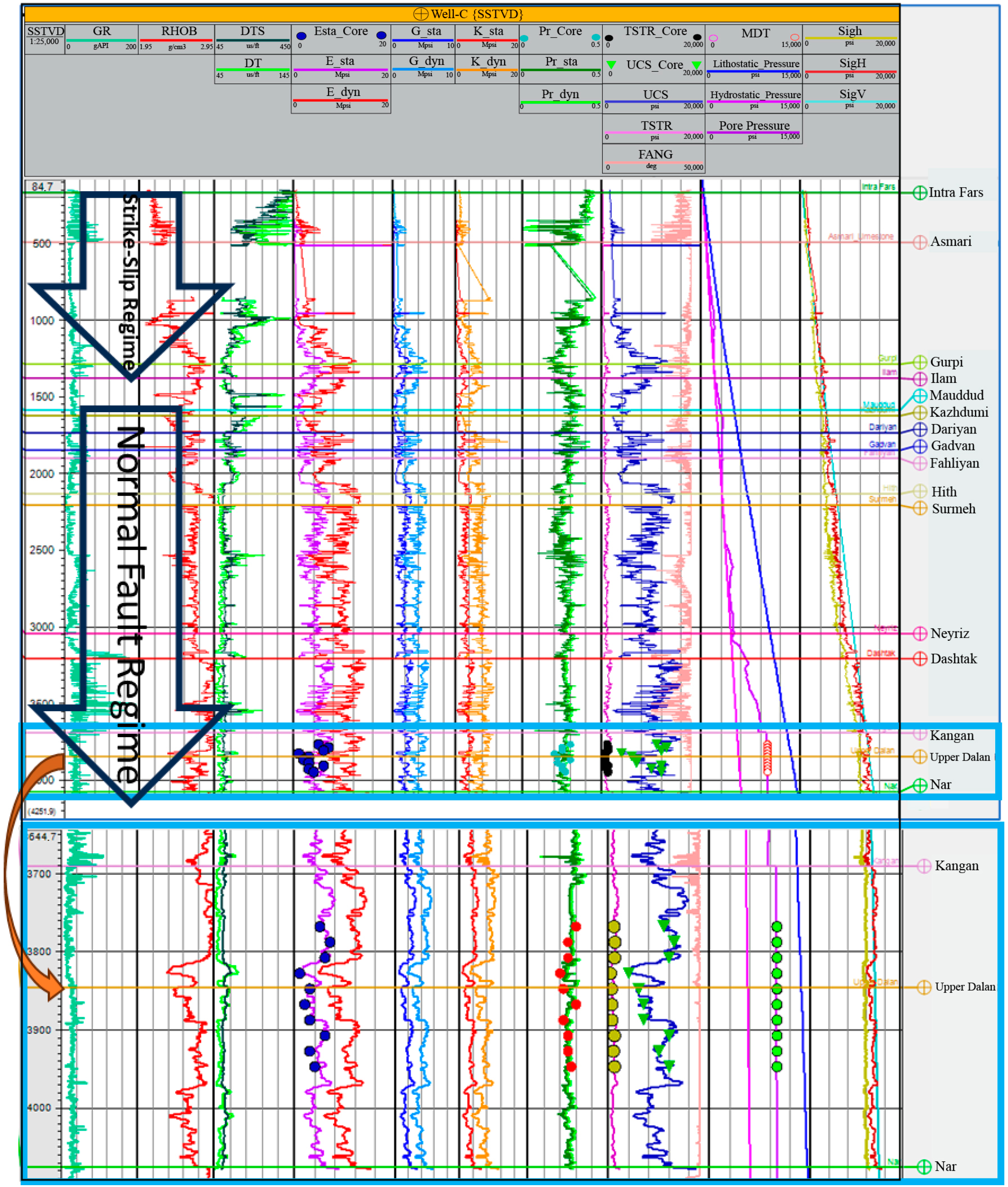
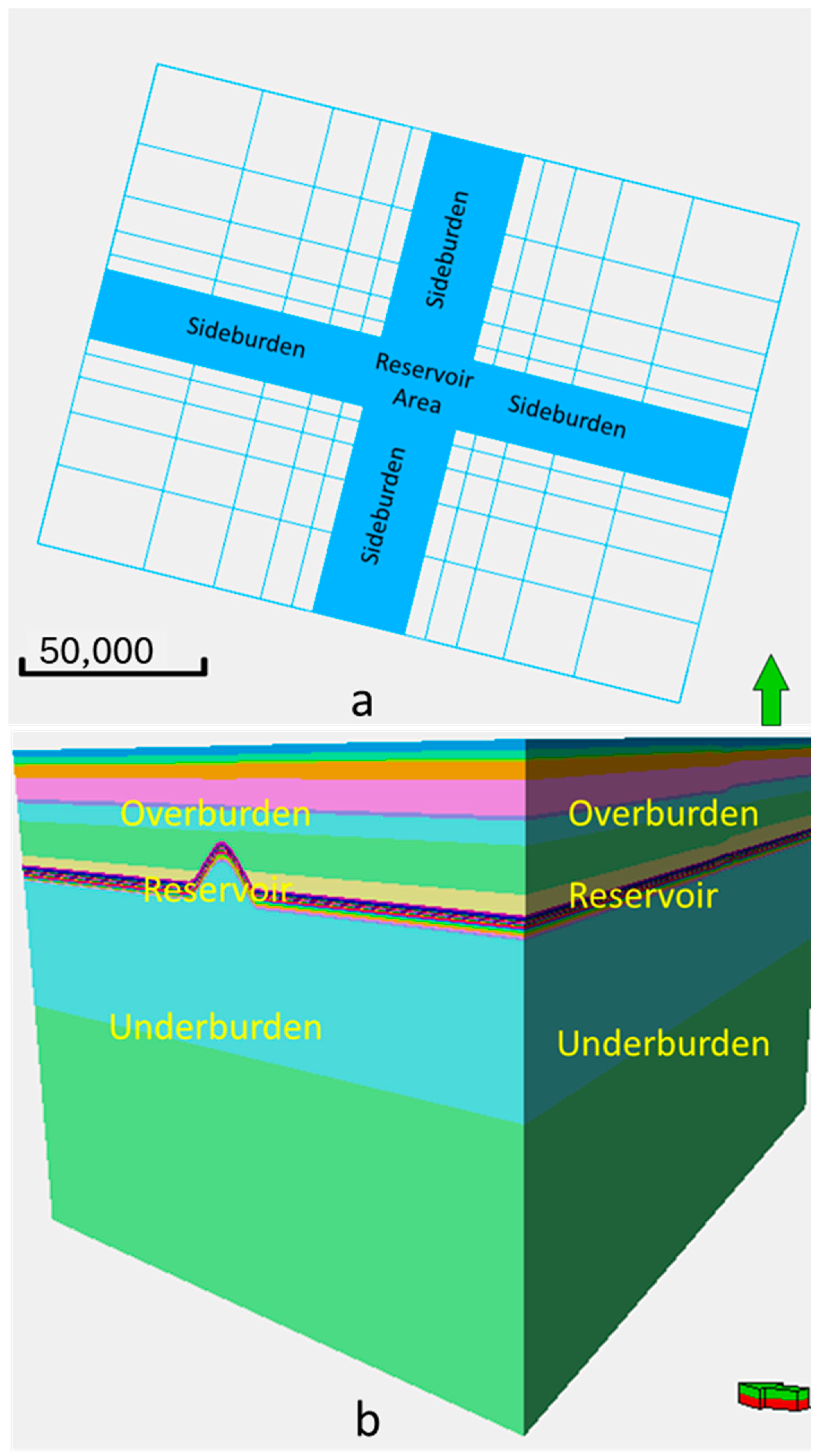

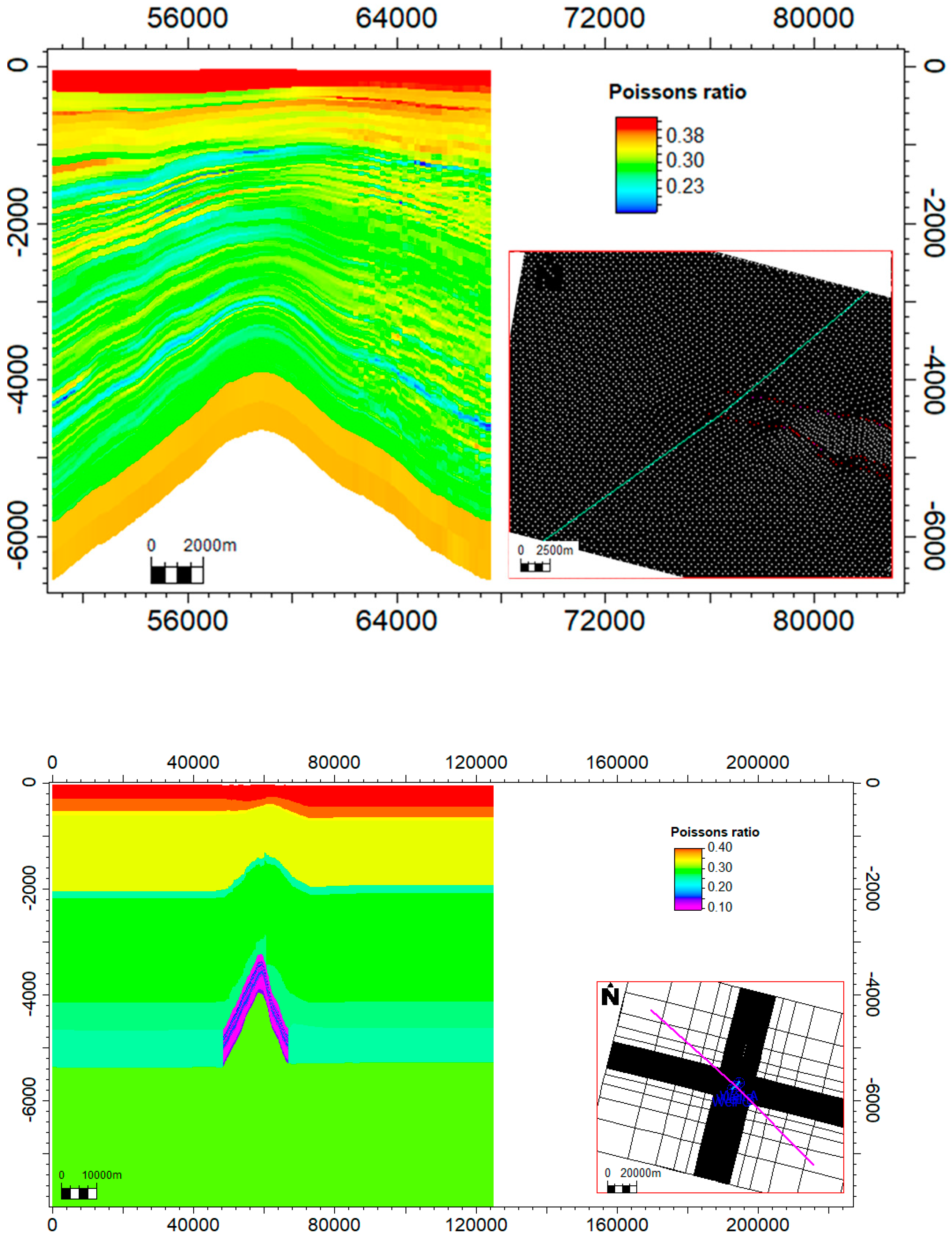

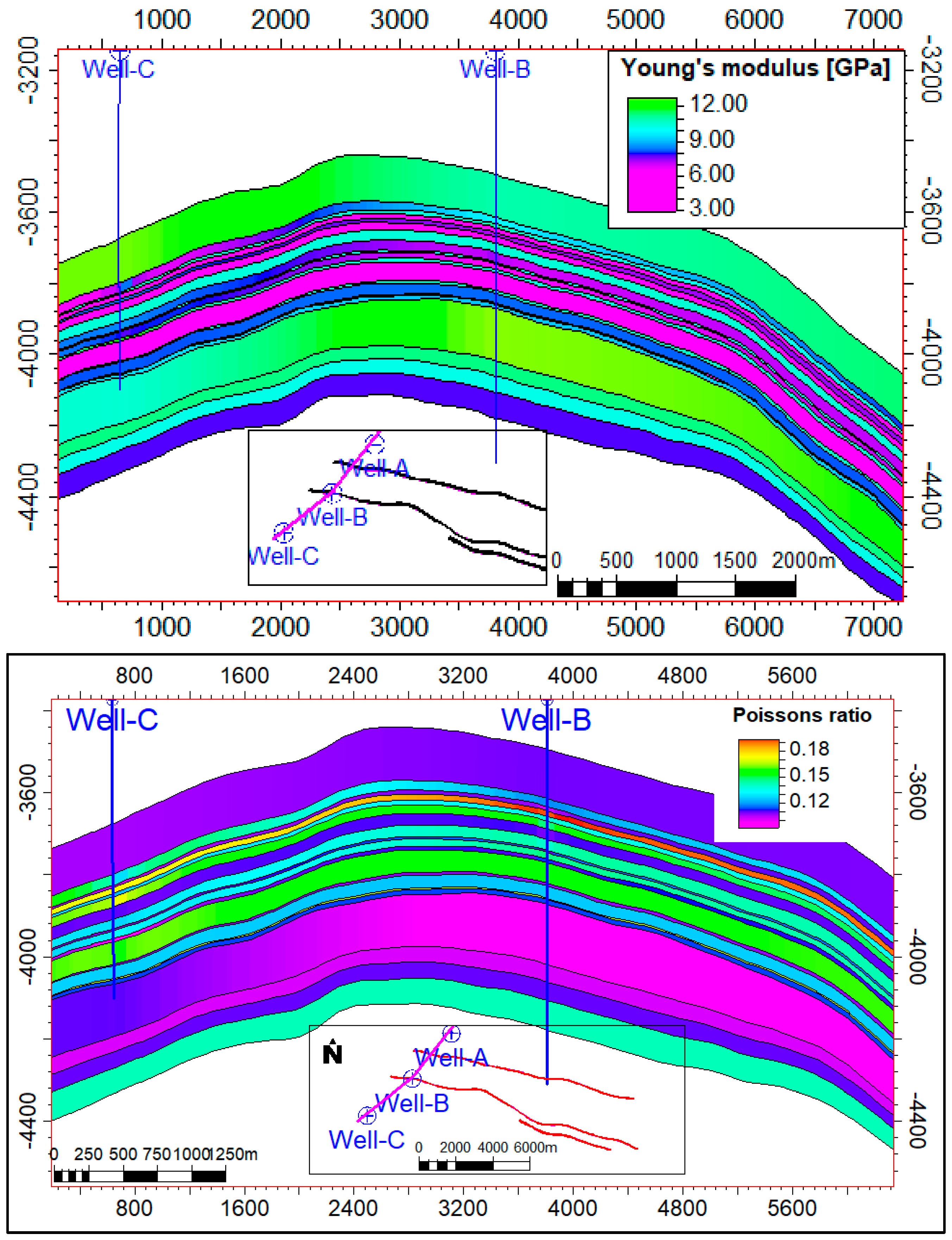
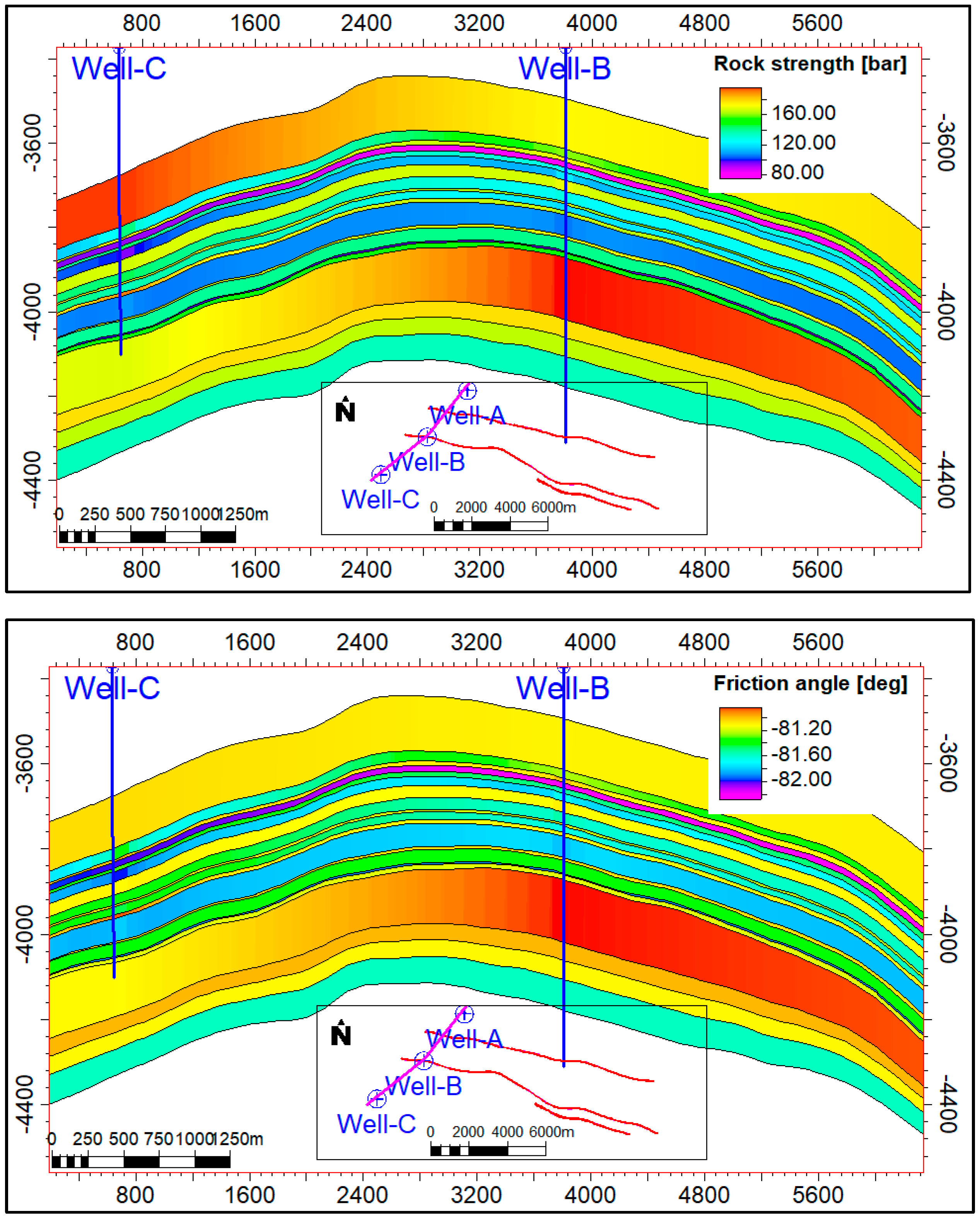

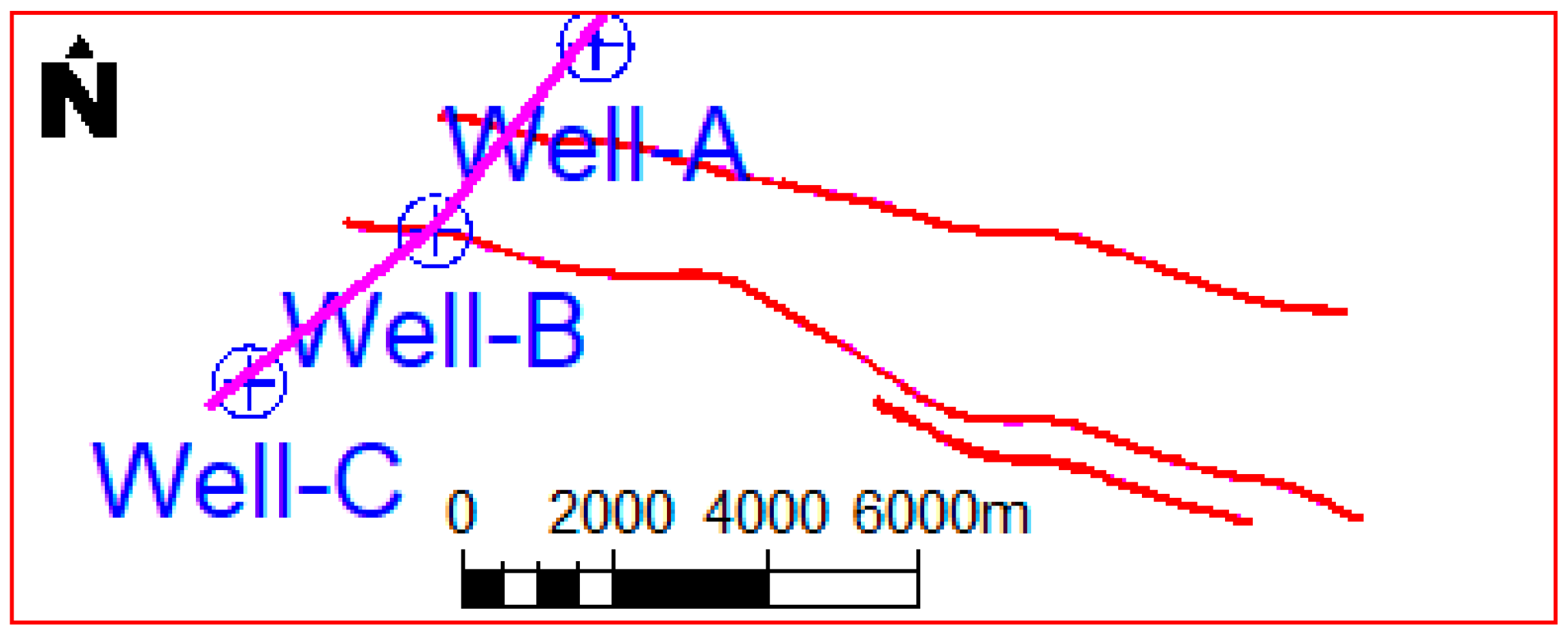
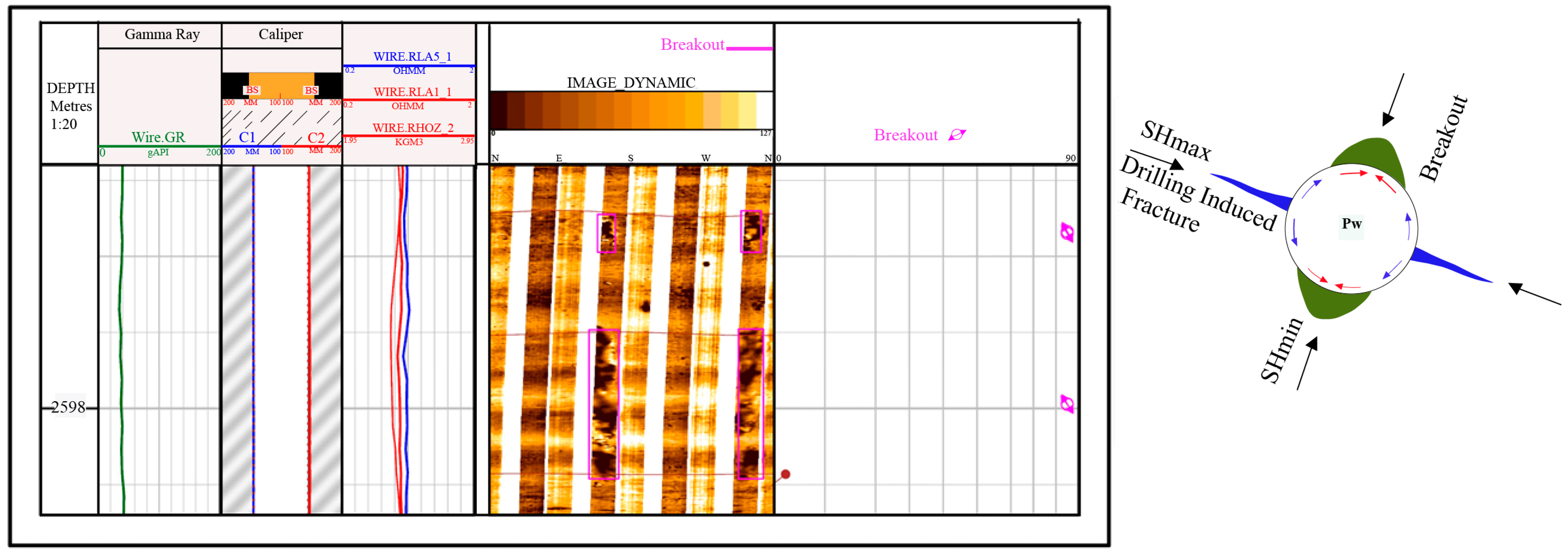

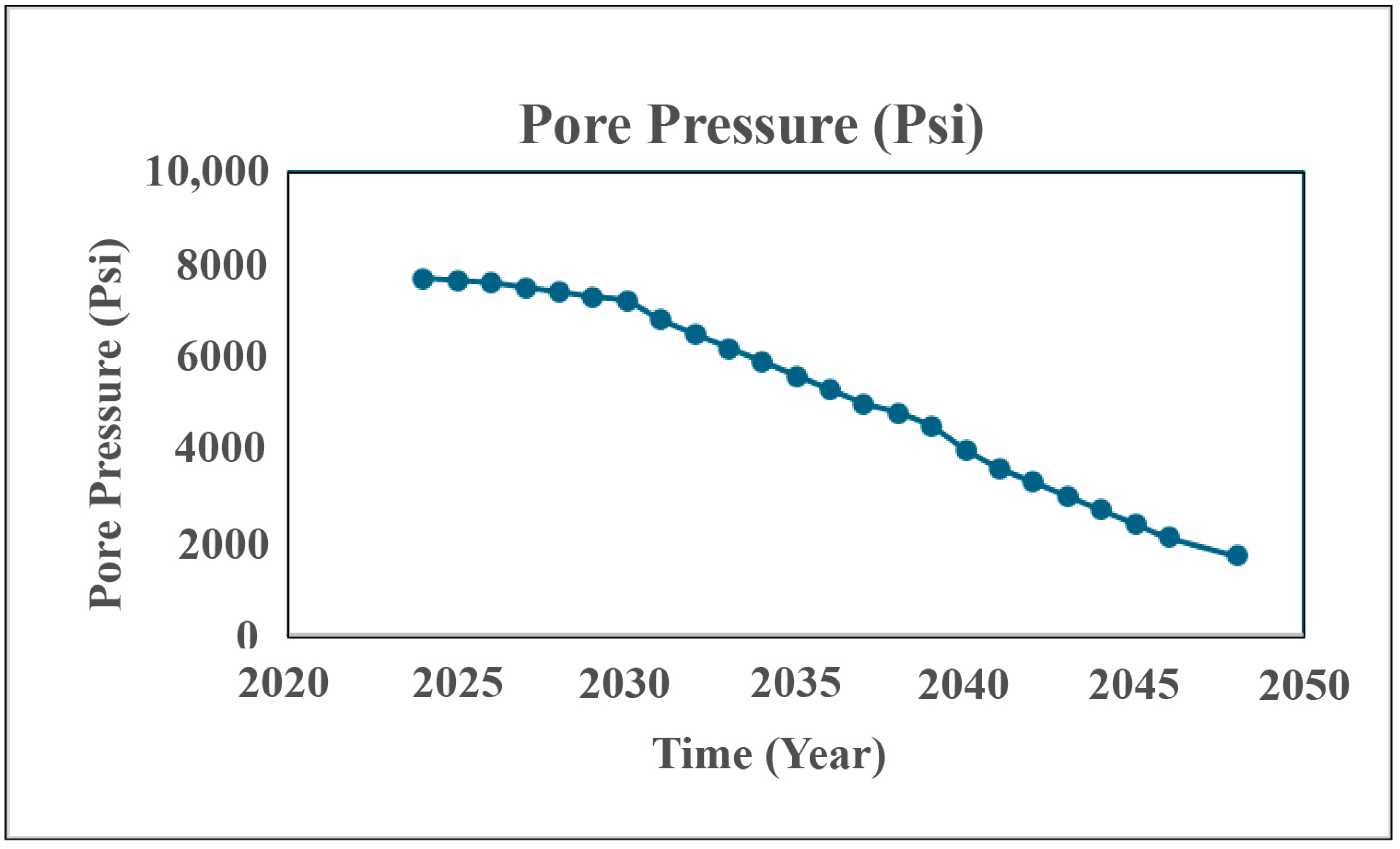
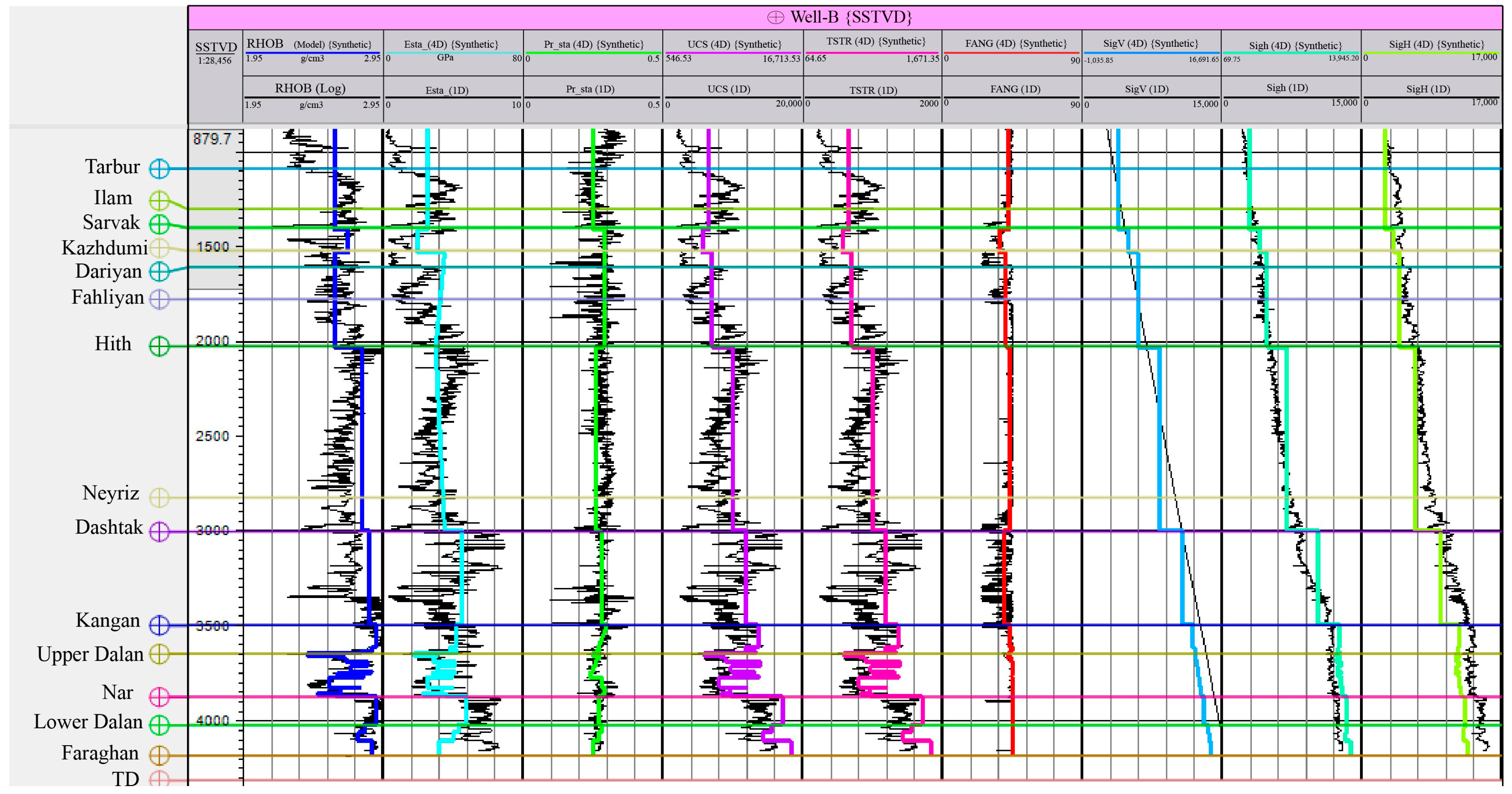
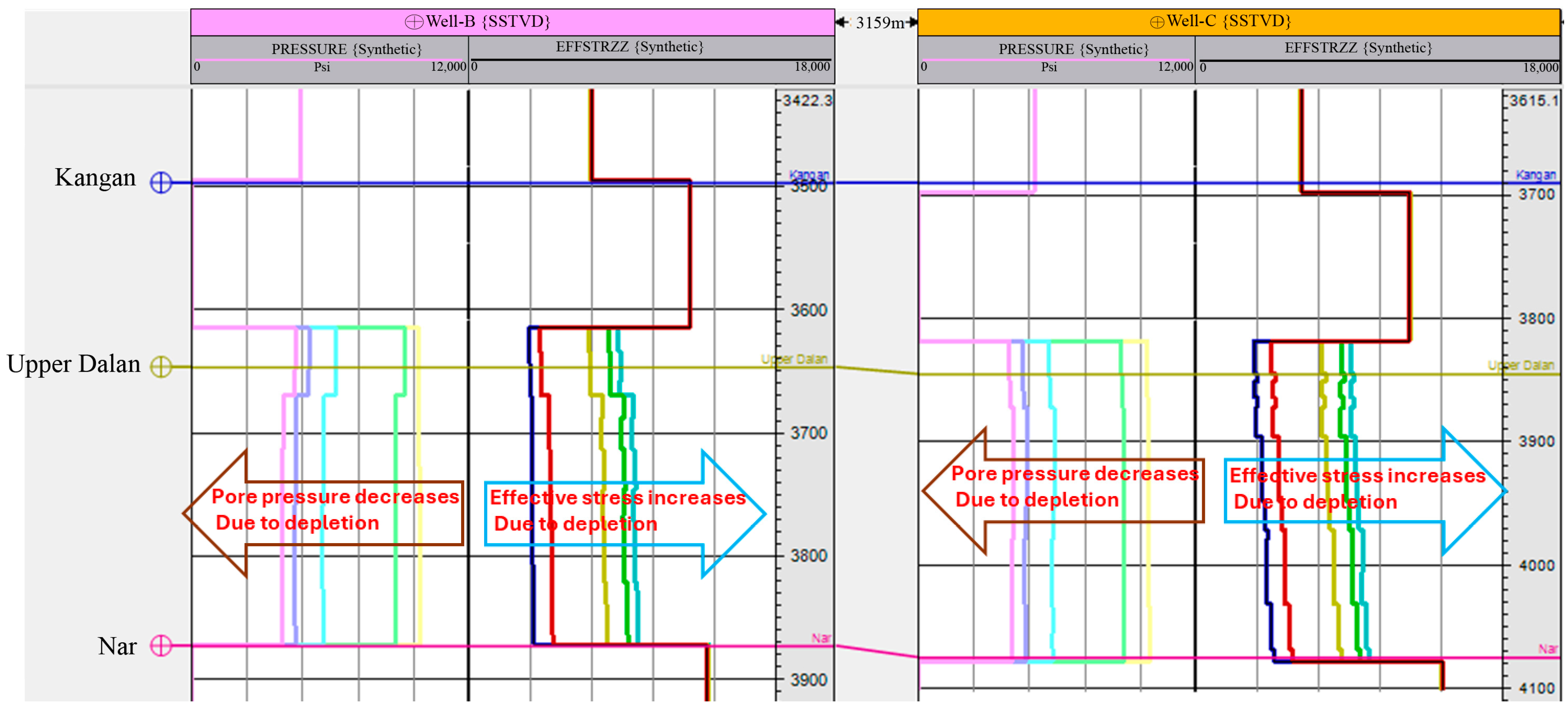
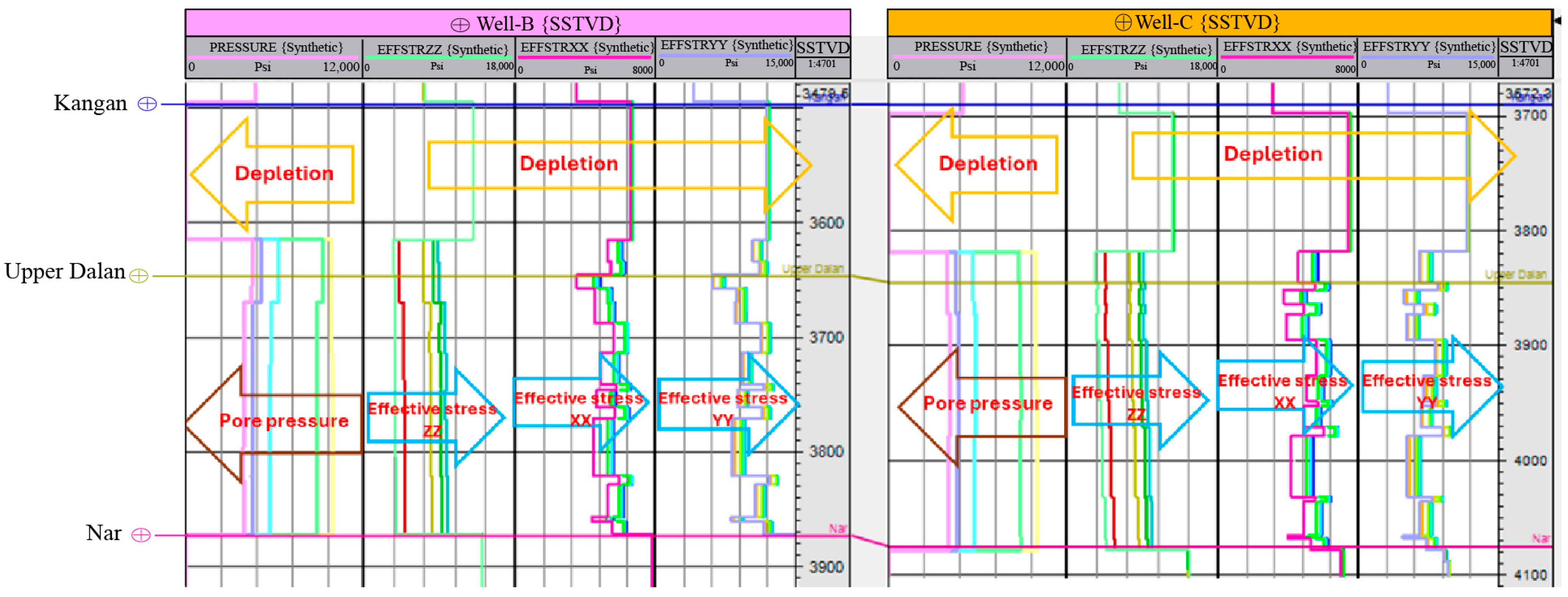
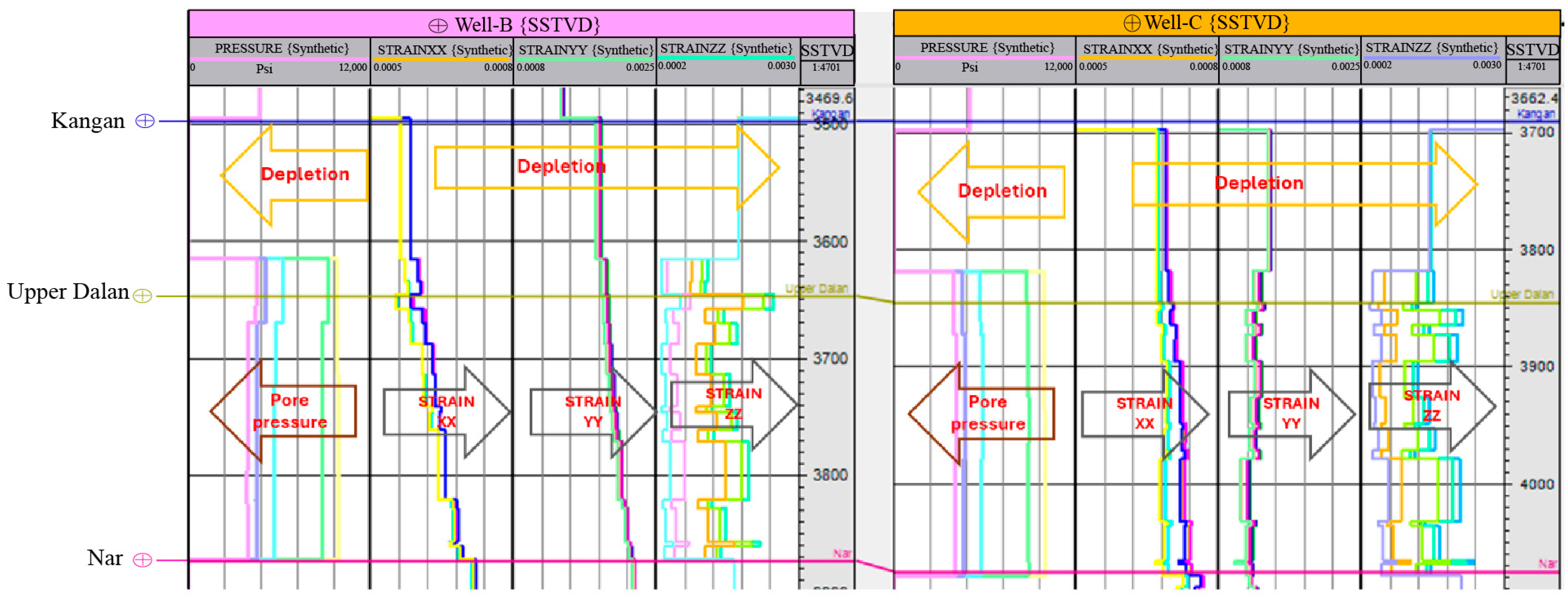

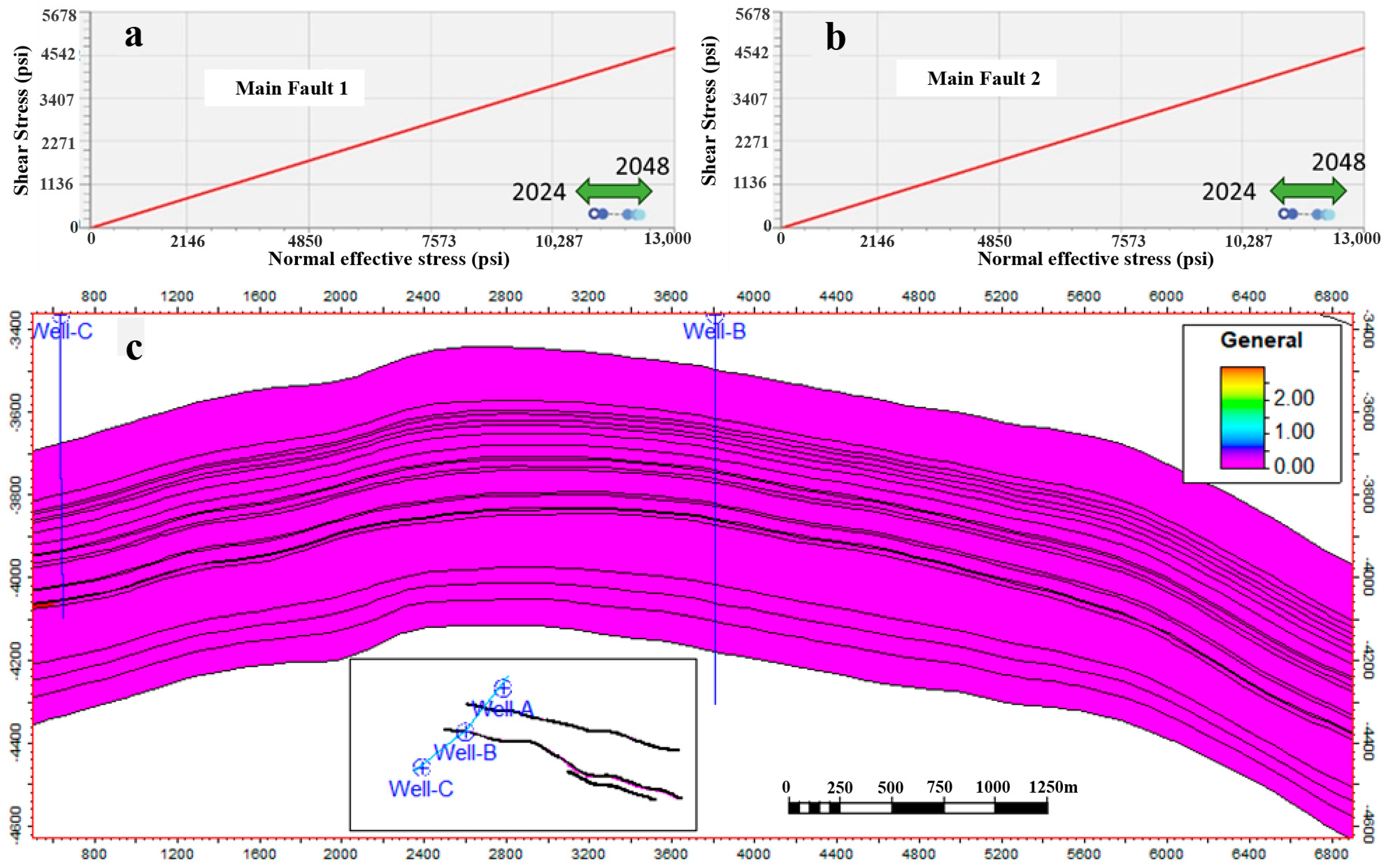

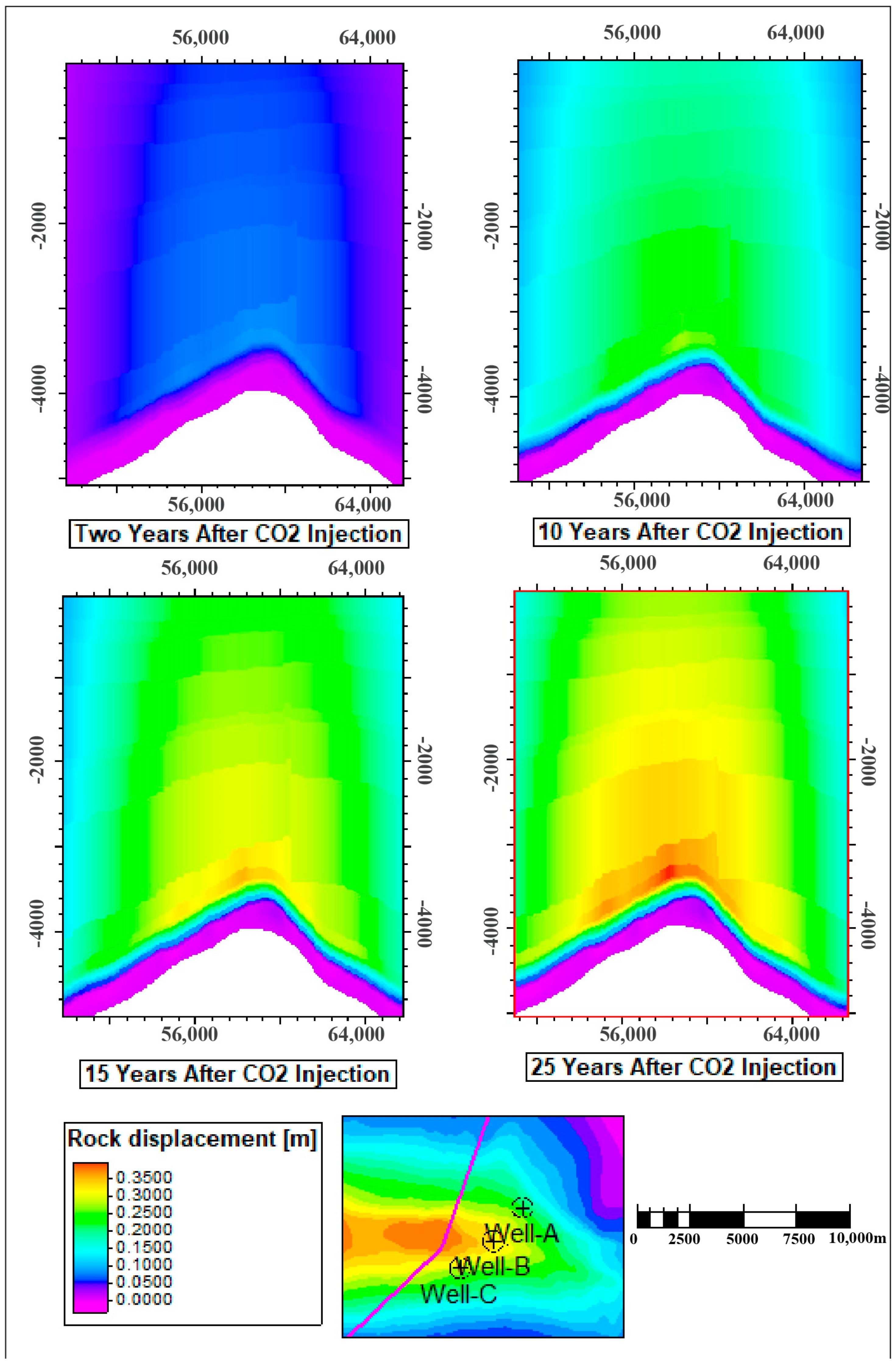
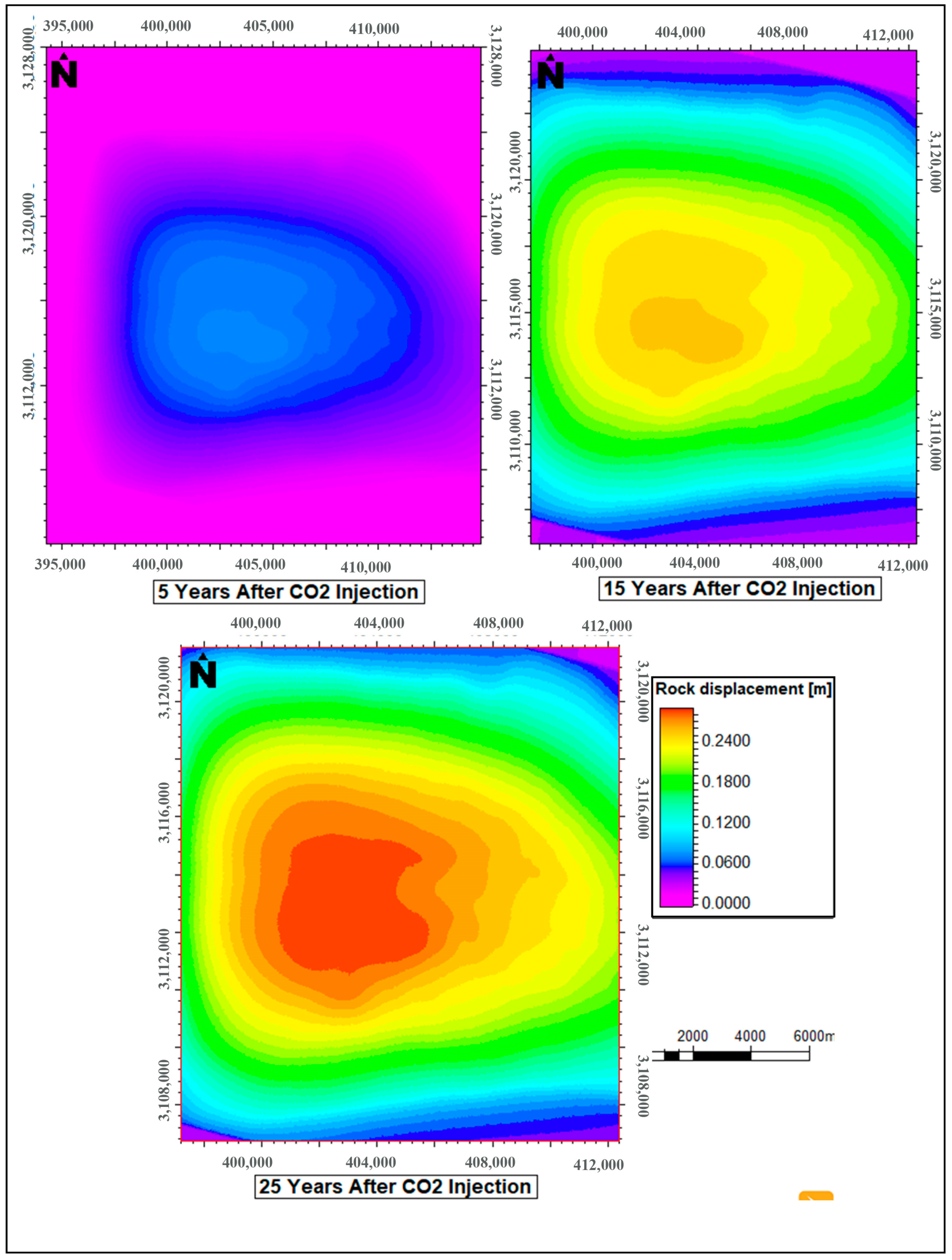
| Well Data | Well A | Well B | Well C | Field Data |
|---|---|---|---|---|
| GR | Y | Y | Y | |
| Sonic compression and shear | Only compression | Y | Y | |
| Density | Y | Y | Y | 3D Seismic |
| Porosity | Y | Y | Y | |
| Image Log | N | N | Y | |
| Calliper | Y | Y | Y | |
| MDT | N | Y | Y | |
| Drilling report | Y | Y | Y | |
| Core data | N | N | Y |
| Parameters | Criteria |
|---|---|
| Linear isotropic | A standard elastic material typically used to establish the magnitudes of in situ stress in generic rock. |
| Non-linear isotropic | Material governed by yield criteria (e.g., Mohr–Coulomb) with parameters including strength and friction angle. These are required for Mohr–Coulomb plastic-deformation breakout calculations in the mud-weight window plug-in. |
| Plate | Typically has a Young’s modulus 1.5 times higher than the highest modeled value. |
| Underburden | A standard material is utilized to accurately model stress transfer within the model, with properties intended to closely resemble the average values obtained from calibrated logs and/or seismic. |
| Fault Non-linear | Discontinuity characteristics featuring yield criteria and supplementary normal and shear stiffness terms. |
| Fm/Mbr Name | Depth (m) | Thickness (m) | Average Vp (m/s) | Average vs. (m/s) | Average ρ (g/cm3) | Average E (GPa) | Average ν |
|---|---|---|---|---|---|---|---|
| Seabed | 75.00 | 263.00 | 2263.00 | 900.00 | 1.90 | 1.00 | 0.35 |
| Lower Fars | 338.00 | 127.00 | 2400.00 | 1200.00 | 1.93 | 1.00 | 0.33 |
| Asmari | 465.00 | 34.00 | 2700.00 | 1250.00 | 2.00 | 2.00 | 0.33 |
| Jahrum | 499.00 | 618.00 | 3400.00 | 1300.00 | 2.16 | 3.00 | 0.25 |
| Tarbur | 1117.00 | 121.00 | 5800.00 | 1900.00 | 2.60 | 8.00 | 0.25 |
| Gurpi | 1238.00 | 91.00 | 5100.00 | 3000.00 | 2.60 | 8.00 | 0.25 |
| Ilam | 1329.00 | 100.00 | 5900.00 | 3200.00 | 2.60 | 8.00 | 0.25 |
| Sarvak | 1429.00 | 120.50 | 4900.00 | 2800.00 | 2.70 | 6.00 | 0.29 |
| Kazhdumi | 1549.50 | 86.50 | 4100.00 | 2200.00 | 2.60 | 4.00 | 0.29 |
| Dariyan | 1636.00 | 114.00 | 4000.00 | 2100.00 | 2.60 | 7.00 | 0.29 |
| Gadvan | 1750.00 | 55.00 | 4300.00 | 2250.00 | 2.60 | 6.00 | 0.29 |
| Fahliyan | 1805.00 | 248.00 | 4800.00 | 2900.00 | 2.60 | 6.00 | 0.29 |
| Hith | 2053.00 | 35.50 | 5900.00 | 3200.00 | 2.80 | 12.00 | 0.26 |
| Surmeh | 2088.50 | 764.50 | 5600.00 | 3000.00 | 2.70 | 7.00 | 0.26 |
| Neyriz | 2853.00 | 180.00 | 5300.00 | 2900.00 | 2.80 | 7.00 | 0.26 |
| Dashtak | 3033.00 | 494.50 | 6300.00 | 3250.00 | 2.90 | 12.00 | 0.28 |
| Kangan | 3527.50 | 149.32 | 5800.00 | 3150.00 | 2.90 | 10.00 | 0.28 |
| Fm/Parameter | Vp (km/s) | Vs (km/s) | ρ (g/cm) | E (Gpa) | ν | UCS (bar) | TSTR (bar) | Φ (deg) |
|---|---|---|---|---|---|---|---|---|
| Kangan | 6 | 4 | 2.9 | 42 | 0.12 | 174 | 17.4 | 81.1 |
| Upper Dalan | 5.4 | 3.4 | 2.5 | 30 | 0.16 | 142 | 14.2 | 81.6 |
| Nar | 6.3 | 4.2 | 2.9 | 47 | 0.09 | 190 | 19 | 80.0 |
| Lower Dalan | 5.4 | 3.5 | 2.7 | 32 | 0.14 | 134 | 13.4 | 81.6 |
| Fault Parameters | Magnitude | Unit |
|---|---|---|
| Normal Stiffness | 309,452.53 | psi/ft |
| Shear Stiffness | 110,518.76 | psi/ft |
| Cohesion | 0.02 | bar |
| Friction Angle | 25.00 | deg |
| Dilation Angle | 10.00 | deg |
| Tensile Strength | 0.01 | bar |
| Initial Opening | 0.00 | m |
| Boundary Condition | Value | Unit |
|---|---|---|
| Sh Gradient | 0.21 | bar/m |
| Sh Offset | 0.00 | psi |
| SH/Sh | 1.20 | - |
| Sh Azimuth | 20.00 | degree |
| Sea Fluid Pressure Gradient | 0.43 | psi/ft |
| Author(s) | Field of Study | Subsidence Magnitude (cm) |
|---|---|---|
| Ranjbar et al. (2017) [31] | An oil field located in southwestern Iran | 0.29 * |
| Mahajan et al. (2018) [32] | Fahud West oil field in the Sultanate of Oman | 23 |
| Moorthy et al. (2022) [71] | Offshore Malay Basin, Malaysia | 35 to 25 |
| Younessi et al. (2023) [73] | South Senoro field in the Eastern Indonesia | 11.1 |
| Shad et al. (2023) [30] | An oil field located in southwestern Iran | 7 |
Disclaimer/Publisher’s Note: The statements, opinions and data contained in all publications are solely those of the individual author(s) and contributor(s) and not of MDPI and/or the editor(s). MDPI and/or the editor(s) disclaim responsibility for any injury to people or property resulting from any ideas, methods, instructions or products referred to in the content. |
© 2024 by the authors. Licensee MDPI, Basel, Switzerland. This article is an open access article distributed under the terms and conditions of the Creative Commons Attribution (CC BY) license (https://creativecommons.org/licenses/by/4.0/).
Share and Cite
Hosseinzadeh, S.; Abdollahi, R.; Salimzadeh, S.; Haghighi, M. Three-Dimensional Coupled Temporal Geomechanical Model for Fault-Reactivation and Surface-Deformation Evaluation during Reservoir Depletion and CO2 Sequestration, Securing Long-Term Reservoir Sustainability. Sustainability 2024, 16, 8482. https://doi.org/10.3390/su16198482
Hosseinzadeh S, Abdollahi R, Salimzadeh S, Haghighi M. Three-Dimensional Coupled Temporal Geomechanical Model for Fault-Reactivation and Surface-Deformation Evaluation during Reservoir Depletion and CO2 Sequestration, Securing Long-Term Reservoir Sustainability. Sustainability. 2024; 16(19):8482. https://doi.org/10.3390/su16198482
Chicago/Turabian StyleHosseinzadeh, Sirous, Reza Abdollahi, Saeed Salimzadeh, and Manouchehr Haghighi. 2024. "Three-Dimensional Coupled Temporal Geomechanical Model for Fault-Reactivation and Surface-Deformation Evaluation during Reservoir Depletion and CO2 Sequestration, Securing Long-Term Reservoir Sustainability" Sustainability 16, no. 19: 8482. https://doi.org/10.3390/su16198482







